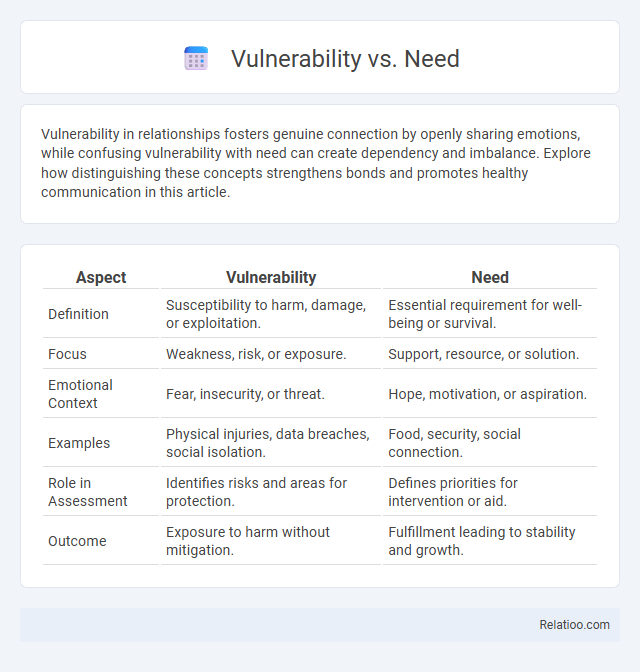Vulnerability in relationships fosters genuine connection by openly sharing emotions, while confusing vulnerability with need can create dependency and imbalance. Explore how distinguishing these concepts strengthens bonds and promotes healthy communication in this article.
Table of Comparison
| Aspect | Vulnerability | Need |
|---|---|---|
| Definition | Susceptibility to harm, damage, or exploitation. | Essential requirement for well-being or survival. |
| Focus | Weakness, risk, or exposure. | Support, resource, or solution. |
| Emotional Context | Fear, insecurity, or threat. | Hope, motivation, or aspiration. |
| Examples | Physical injuries, data breaches, social isolation. | Food, security, social connection. |
| Role in Assessment | Identifies risks and areas for protection. | Defines priorities for intervention or aid. |
| Outcome | Exposure to harm without mitigation. | Fulfillment leading to stability and growth. |
Understanding the Concepts: Vulnerability and Need
Vulnerability refers to the susceptibility of individuals or groups to harm due to factors such as economic instability, health issues, or social exclusion, while need represents the specific deficiencies or requirements essential for survival and well-being, like access to food, shelter, or healthcare. Understanding vulnerability involves recognizing underlying conditions that increase risk exposure, whereas need focuses on tangible aids necessary to alleviate hardships. This distinction guides targeted interventions by addressing both the root causes of vulnerability and the immediate necessities to improve quality of life.
Key Differences Between Vulnerability and Need
Vulnerability refers to a state of increased susceptibility to harm due to factors such as age, disability, or social status, while need specifically denotes a lack of essential resources or support required for well-being. Vulnerability emphasizes potential risk exposure, whereas need highlights an immediate requirement for assistance or intervention. Understanding these distinctions aids in precise targeting of aid and policies to address both potential risks and current deficiencies effectively.
Types of Vulnerabilities and Their Impact
Types of vulnerabilities such as physical, emotional, and financial significantly influence individual needs by shaping access to resources and support systems. Physical vulnerabilities, including disabilities or chronic illnesses, often necessitate specialized healthcare and adaptive technologies, while emotional vulnerabilities like trauma or mental health challenges increase the requirement for psychological support and community inclusion. Financial vulnerabilities reduce access to basic necessities, impacting deservingness perceptions and prioritizing socioeconomic interventions.
Identifying Different Forms of Need
Identifying different forms of need involves distinguishing between physical, emotional, and social vulnerabilities that affect individuals uniquely. Physical needs encompass basic survival requirements such as food, shelter, and healthcare, while emotional needs pertain to psychological support and mental well-being. Social needs include belonging, acceptance, and access to resources that empower individuals, highlighting the complex interplay between vulnerability and deservingness in resource allocation.
The Role of Vulnerability in Social Policy
Vulnerability plays a critical role in shaping social policy by identifying populations at risk who require targeted support beyond general needs assessments. Unlike need, which is often quantified based on resource deficits, and deservingness, which is influenced by societal judgments, vulnerability captures the exposure to harm and the capacity to cope with adverse conditions. Your understanding of vulnerability can help policymakers design more equitable interventions that prioritize protection and resilience for those most susceptible to social and economic hardships.
Prioritizing Resource Allocation: Vulnerability vs Need
Prioritizing resource allocation requires distinguishing vulnerability from need, as vulnerability reflects exposure to harm while need denotes immediate requirements for survival or well-being. Allocating resources based on vulnerability targets prevention and long-term resilience, whereas need-based allocation addresses urgent, short-term deficits. Effective strategies balance these dimensions to optimize impact, ensuring resources serve both those at highest risk and those facing critical deprivation.
Assessment Tools for Measuring Vulnerability and Need
Assessment tools for measuring vulnerability and need include indices such as the Vulnerability Index Service Prioritization Decision Assistance Tool (VI-SPDAT), which evaluates factors like housing stability, health conditions, and social support to prioritize services. The MULTI-DIMENSIONAL POVERTY INDEX (MPI) assesses deprivation across health, education, and living standards to identify populations requiring assistance. These tools combine quantitative data and qualitative assessments to determine deservingness by aligning resource allocation with individuals' levels of vulnerability and urgent needs.
Challenges in Distinguishing Vulnerability from Need
Distinguishing vulnerability from need poses significant challenges due to their overlapping characteristics, but vulnerability often implies a higher risk of harm or lack of resilience, whereas need refers to a more immediate requirement for resources or support. Assessing vulnerability requires considering factors like socioeconomic status, health conditions, and exposure to systemic risks, while needs focus on specific, tangible deficits. Your ability to accurately identify vulnerability versus need directly impacts the effectiveness of targeted interventions and resource allocation.
Case Studies: Practical Applications and Outcomes
Case studies examining vulnerability, need, and deservingness reveal critical insights into resource allocation and social policy outcomes. Programs targeting vulnerable populations often evaluate the severity of need and perceived deservingness to optimize support effectiveness, as seen in housing assistance and healthcare initiatives. Your understanding of these practical applications can enhance policy design, ensuring equitable distribution of resources based on empirical evidence from real-world examples.
Future Directions for Research and Policy Integration
Future research should prioritize developing integrated frameworks that distinguish vulnerability, need, and deservingness to enhance targeted social policies. Advances in data analytics and machine learning can provide granular insights into these dimensions, improving resource allocation and policy effectiveness. You can expect policies informed by such research to better address systemic inequalities, ensuring fairer distribution of social services.

Infographic: Vulnerability vs Need
 relatioo.com
relatioo.com